Today we commemorate the 80th anniversary of D-Day. The amphibious assault part of that invasion was code named Operation Neptune. Recently, we have fielded a number of questions about World War 2 and the roles that local folks played in that conflict.
The Conway Public Library’s Henney History Room supports research on both an international and family scale.
For example, I was able to discover that my uncle Warren was involved in the development of the amphibious vehicles used on D-Day. He was a mechanic and worked for Donald Roebling, the great grandson of fabled bridge engineer John Augustus Roebling, who designed the Brooklyn Bridge.
Donald Roebling moved to Clearwater, Florida in 1929. His arrived about six months after the Great Lake Okeechobee Hurricane of September 16, l928, which swept across Lake Okeechobee, inundating newly developed tracts, killing 1,836 a residents and causing $25 million in damages.
Many of the storm’s victims expired after the hurricane because rescuers were unable to reach them across so many miles of flooded, muddy swamps created by the storm. Roebling realized that an amphibious vehicle that could travel on land, swamps, and across deep water might have saved hundreds of lives. Between 1933-37 Roebling supervised the construction of four increasingly sophisticated amphibious tractors, culminating in the Alligator.











